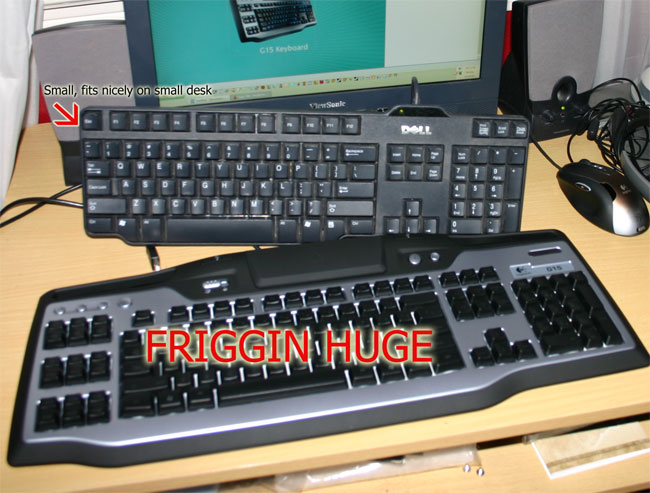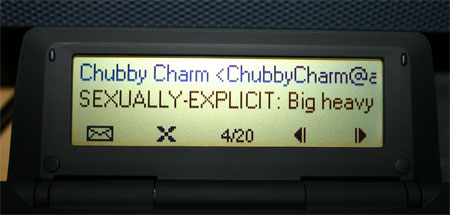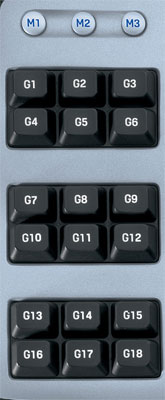Logitech has been in the peripheral business for a long time. They’ve been known throughout the years as “the old standby” for third party input devices such as mice, keyboards, and game controllers. When you’ve been in that position for as long as they have, it can be hard to break out of the stale, stodgy, “Aunt Sally’s mouse” image. Gamers looking for the next level of interface have traditionally turned to boutique manufacturers such as Razer or ZBoard.
Logitech decided to step into the arena by releasing their “G” series of gaming-specific peripherals, such as the G5 and G7 gaming mice (review here) and their new keyboard, the G15 Gaming Keyboard. Today we will be looking at the G15.

I basically type and mouse for a living, and like most of you, the keyboard is one of the two critical input devices that I use for a significant portion of my life. I have always been very picky about my keyboards, and once I find one that I like, I beat it into the ground. I had been using an old, ugly, beige Compaq-branded keyboard for several years, and believe me it had some battle wounds. It was filthy, and the old PS2 connector had to be cut down with a rasp file to fit into any PC other than an old Compaq Presario that it came with. Despite its flaws, it has just the right “clicky” feel that I like, and I was loathe to replace it. Then one day not so long ago, I ordered a Dell server and with it came a tiny black USB keyboard that was quite strange looking. I hooked it up, tried it out, and fell in love. It became my new favorite; Sleek, black, a small footprint, USB, and a fantastic tactile response made sure it ousted my beloved, oddball Compaq. I eagerly got my hands on more of those small Dell branded keyboards (which I discovered was actually designed by a firm called NPK Design.) and it’s hard to imagine a better keyboard. Then my friends at Logitech contacted me and told me they were sending their new G15 Gaming Keyboard. When I got it home and unpacked it, I was horrified to see how huge it was.

Friggin Huge!
It easily dwarfed my Dell keyboard on all four sides. When I put it on my tiny desk, I barely had room for my mouse. Due to the size of my desk, I had to sort of tilt the keyboard at maybe a 20 degree (counterclockwise) angle to re-center it. If I moved it over to the left to make room for my mouse, it wasn’t centered under my monitor anymore and my arms were a few inches more leftwards than was comfortable. Take note: If you want to buy this keyboard, make sure you have room for it. It is 21.5″ at its widest and 9″ deep in the middle. It’s big.
Then I plugged it in. I got over the freaking hugeness of the keyboard pretty fast when I saw the pretty blue lights. Every key is backlit. There are three settings: Off, dim, and bright. In the dark, it makes the keyboard look pretty bad ass when every key is lit up blue.
Then, I remembered that I had seen a little LCD screen on the box art. Ah ha! In the top center of the keyboard there was a rubberized lid. I lifted it and discovered the joy of the built in LCD screen.
The possible uses of the screen are numerous. The keyboard comes bundled with a few apps for the LCD panel such as a time and date panel, a CPU and RAM meter, a POP3 email reader, and a stopwatch applet. There is a community of modders that write applets for the panel, and Logitech has made the SDK available so that astute programmers can write their own.

I can read my most important emails with the LCD panel alone!
There are even more buttons underneath the LCD panel, such as an applet switcher, a volume knob, and media control keys, as well as four context-based buttons to interact with the applets on the panel.
Another nice feature is the two extra USB ports on the back of the keyboard, although I discovered they are only USB 1.1 ports. It would have been nice to have them be 2.0 compatible. They’re perfect for USB memory sticks, but the 1.1 speed limits their usefulness considerably.
The tactile response of the keys is quite good. It’s not quite up to the standard set by my ancient Compaq thingamajig, but it’s close. It’s good enough that I am willing to use the keyboard on a daily basis
One more useful feature is a switch that allows you to disable the Windows key when you are gaming. I also find it quite useful to disable the Windows key when I am using Photoshop, due to all the keyboard shortcuts involving the ALT and CTRL keys. I used to find myself hitting the Windows key all the time while trying to work on photos and now that problem doesn’t exist anymore.
 Now we get to the “killer app” – the feature that sets the G15 apart from most other keyboards. There are eighteen “G” keys on the far left side of the keyboard, along with three “bank switcher” keys. The G keys are fully programmable keys that allow you to set up to 54 macros. The macros can be as simple as a keystroke or as complicated as a full series of keypresses with recordable pauses. If you want to use Bank 1 (1-18), you press the “M1” key. Bank 2 is “M2”, and so on. With the macro recording software, it is very easy to configure the keys to do all sorts of things.
Now we get to the “killer app” – the feature that sets the G15 apart from most other keyboards. There are eighteen “G” keys on the far left side of the keyboard, along with three “bank switcher” keys. The G keys are fully programmable keys that allow you to set up to 54 macros. The macros can be as simple as a keystroke or as complicated as a full series of keypresses with recordable pauses. If you want to use Bank 1 (1-18), you press the “M1” key. Bank 2 is “M2”, and so on. With the macro recording software, it is very easy to configure the keys to do all sorts of things.
These are amazingly useful, even beyond gaming. In fact, I’ll be frank and say I use them more for non-gaming applications than for gaming. For example, when I load PuTTY (the remote SSH program I use for all my unix/linux administration), the PuTTY profile loads up and my G keys are all configured for common shell commands that make my work a lot faster. For example, to get to a mail directory on one of my mail servers I would log in and type ls -lah /var/mail/ to see a quick glance at the size of my mail spools. Now I log in and press the G2 key and it just happens for me. It may seem trivial but when you do a lot of this during the day (along with many other things) the time saved adds up. I even configured a “hot exit” key that quits all my shells and logs out instantly.
For Photoshop, I’ve configured the G keys to do some of the things that used to require convoluted multi-key presses (CTRL+ALT+SHIFT+S for Save to Web, for example). Now, Save to Web is G1!
Certain games that can utilize crazy macros to perform a whole series of commands like Final Fantasy XI or World of Warcraft also benefit greatly from these configurable keys.
On the box art, I saw a picture of the LCD screen showing an in-game chat windows. Curiously, I could not figure out how to get this working for any game. I asked a forum member about it and he pointed me to this page on Logitech’s web site. The documentation or help didn’t mention this, and it doesn’t seem to easy to get there from their main home page, so they could have done a better job showing people how to get the most out of this device. There are only a precious few games supported right now, but the list is growing, especially if you consider the homebrew community.
Conclusion
If you’re willing to spend the money and take a big chunk out of your desktop real estate, this is a fantastic keyboard. The great tactile response is just gravy on top of an already amazing input device. I was skeptical at first, because all those keys and the screen, etc. feel “gimmicky” but they are not. You can use them to do real work and they can definitely help improve your game and your daily tasks. However, it doesn’t do much ‘out of the box’ – you need to hunt down mods for what you want to do or be really hardcore and make them yourself. I would call this an “enthusiast’s” keyboard. You will get more out of this thing if you put the effort into it. It’s worth the money if you are willing to spend the time to get it tweaked out. I guess the ultimate recommendation is that I have replaced my favorite keyboard with it, and I use it everyday. I can truthfully say I love this keyboard.
Highs
- Looks great
- Excellent tactile response
- The LCD is like a whole seperate device
- The G keys are extremely flexible
Lows
- Huge
- USB ports are only version 1.1
- Expensive for a keyboard
- Lack of out-of-box support for all but the most basic applets and macros
- Not very intuitive. You need to be something of a hacker to get the most out of it
| Attribute | Score | Comments |
|---|---|---|
| Bonus items & software | 7 | Bundled software makes configuring the G keys a snap, but the LCD panel requires programming knowledge to get any really cool use out of. |
| Design & layout | 8 | The keys weren’t as snappy and ‘clicky’ as I would have liked, and I think perhaps Logitech could have made this smaller. Take a page out of the design manual for the company that made those Dell keyboards, and this would be ALMOST a perfect 10. |
| Documentation | 6 | Not very helpful for anything but the basic features. I had to have help to hunt down the supported game page and the modder community. |
| Features & options | 10 | Any more features, and this would become more than a keyboard. As it stands, this is an amazing device with more options and features than you know what to do with. |
| Fine-tuning features | 10 | They gave us the SDK. How much more fine tuning could you do? |
| Modding possibilities | 10 | See above…. Mod away, programmers! |
| Presentation | 9 | Logitech’s packaging is always over the top. Looks great out of the box. |
| Price / value | 8 | This is definitely a notch above the $20 office-supply-store special, but considering what you get, I’d say the price is fair. |
| Total score | 68/80 | 85% |







 Articles RSS
Articles RSS